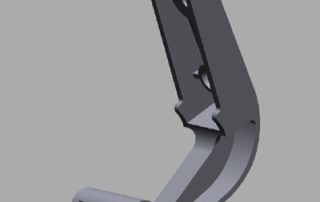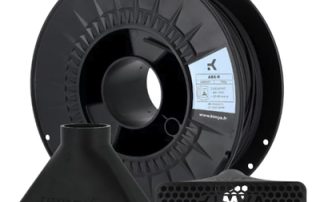Forward AM Filament Materials Deliver on Both Performance and Sustainability
BASF Forward AM is deeply committed to sustainability. They are continuously working to reduce the environmental impact of their materials as well as their use of Earth’s precious resources. To both accelerate and justify their efforts, they recently conducted a detailed SEEbalance assessment for 3D printing technologies. Over the past several months they have evaluated the results and are now incorporating them to make their Ultrafuse® products even more sustainable. Whether it is powder bed fusion, photopolymer, or filaments, they want to provide the best possible materials for your 3D printing projects while also reducing their carbon footprint to protect the environment and our planet for future generations. Let's take a closer look at their filaments and the different measures their material experts took and will continue to take to offer more sustainable options within the Ultrafuse® line. Sustainable Terminology Virgin plastic: Plastic can be made from different natural materials such as crude oil or bio-based materials. When the word virgin plastic is used, it refers to plastic that is newly created without recycled materials. Post-industrial: The word post-industrial means waste that was produced during a manufacturing process but was not used as an end product due to a variety of issues and [...]
UltiMaker 3D Printers Offer Increased Productivity
Experience improved model arrangement on the virtual build plate, powerful new engine plugins, and remarkable productivity improvements for UltiMaker S series printers in the newest version of Cura! Ultimaker S series 3D printers can now print at up to twice the speed UltiMaker is always on a mission to refine their printers. This includes not only their latest machines but also those already in the hands of the users. This Cura release contains one of the best examples of their dedication to continuous improvement with up to double the 3D printing productivity for everyone using our S series printers together with UltiMaker materials. While the raw speed of the S series printers has increased, it should be noted that it is the overall productivity of their printers that has been improved. They have been able to realize this speed increase without reducing print quality or increasing failure rates. This is a huge achievement! Whether you’re using an S7 you bought today or an S5 you bought years ago, you can now print parts in up to half the time, without any reduction in reliability or quality. For instance, in the previous Cura 5.4 release, printing a part in PETG on an [...]
Reverse Engineering Hinge Replacement
Have you ever considered reverse engineering a cabinet hinge replacement? Just imagine that you have a kitchen cabinet door with a broken hinge. Your wife wants to replace all of the cabinets since they are decades old, but you are determined to find a solution that doesn’t involve a completely new kitchen cabinet purchase and installation. You remove the 20+ year-old hinge and take it with you to the local hardware store, in search of a replacement and you find hinges that are “oh so close” but just a slight difference makes it unusable. You come to the realization that your 20+ year old hinge probably just isn’t produced anymore so what do you do? Step 1 – Scan the broken hinge We use our laser scanner to capture all of the necessary detail of the hinge. Step 2 – Reverse Engineer from the scan to a mechanical CAD model We import the scan into Design X reverse engineering software and step our way through the modeling of the bracket based upon the scan features captured from the broken bracket. After the initial Extrusion, we continue modeling the bracket, taking advantage of symmetry as we go. Adding the Small Pocket to the Extruded [...]
KIMYA launches a very popular filament, ABS-R, that’s made with post-consumer recycled materials
ABS (Acrylonitrile Butadiene Styrene) has a long history in the 3D printing world as it was one of the first plastics to be used. Today, ABS is still a very popular material thanks to its excellent mechanical properties such as its toughness and impact resistance as well as its low cost point. These properties allow you to print durable parts that hold up to extra usage, high temperature and wear. KIMYA, an ARMOR GROUP company, has created a new recycled 3D filament; an ABS material named ABS-R because it’s made from 100% post-consumer recycled material. This new development is part of KIMYA’s ongoing commitment to a more sustainable and circular production. They have dedicated their “remake” range to this mission because each filament within this range is made from recycled materials. The Kimya recycled ABS-R is the first filament from the “Remake” range produced from 100% post-consumer recycled material. In other words: the Kimya recycled ABS is made entirely from plastics obtained from recycled household waste and electronic products (e.g.Phone casings). Benoît Stoeux, KIMYA's Managing Director says, “Eager to always go further in our circular economy approach, we took an interest in post-consumer plastics which are highly more complex [...]
Metrology Minute – Importing PMI and Step 242
In past Metrology Minute articles, we discussed the ability to import PMI data into Control X using the File, Import PMI option. As a reminder, PMI (Product Manufacturing Information) allows dissimilar systems to share manufacturing information specifically related to dimensioning and tolerances. So, for example, a Solidworks user can add PMI to their Solidworks model (see example below) using the MBD tab and then that PMI information, including but not limited to; Datums, dimensions with tolerances, GD&T, notes, labels, etc. may be transferred with the model into programs like Control X, to be used for inspection calculations. But what if a Solidworks user wants to provide a PMI model to a supplier but doesn’t necessarily want to provide their native SW model? Historically there have been two Step formats; Step 203 and Step 214. A few years ago, a new Step format was introduced called Step 242 which is basically a Step file that also includes PMI information. This means that along with the Import PMI capabilities in Control X whereby the CAD model and associated PMI values are all imported, Control X now also provides a Step 242 Import capability. Most CAD systems that can create PMI information to be added to [...]
KIMYA Post-consumer Recycled 3D Printing Filament
KIMYA, an ARMOR GROUP company, is continuing the development of its “Remake” range of recycled 3D filaments in 2023 with a new Kimya ABS-R recycled material made from 100% post-consumer recycled material from selective collection. This new development is part of KIMYA’s ongoing commitment to a more sustainable and circular production. KIMYA ABS-R, a post-consumer recycled filament KIMYA, is continuing the development of its “Remake” range with a new 3D filament: the recycled ABS-R filament, made from 100% post-consumer recycled material from selective collection. A first for KIMYA, which initially focused on post-industrial plastics. Properties of the Kimya recycled ABS-R KIMYA recycled ABS-R (acrylonitrile butadiene styrene) is a thermoplastic polymer offering high impact resistance and is relatively rigid and lightweight. Operational on all 3D printers on the market and perfectly adapted for outer casing applications, ABS is popular among professionals in sectors such as domestic appliances, telephony, IT equipment, and toys. Benoît Stoeux, Managing Director of KIMYA: “With this filament; we are offering our ABS material users a new; greener alternative to satisfy their standard printing needs. For applications requiring high-impact resistance and a food contact certification, we are offering the Kimya ABS -S”. Post-consumer vs. Post-industrial Itself an industrial company, [...]






